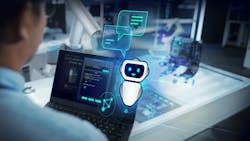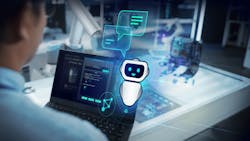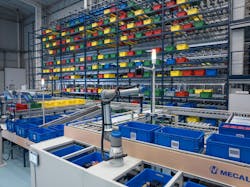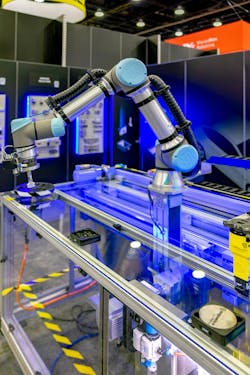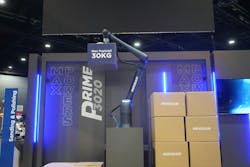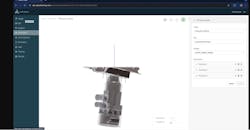Automate 2024 Wrap-up: Shifting the Robotics Paradigm to Flexible, Agnostic Solutions
To the uninitiated, the number of AI use cases on display at Automate 2024 might signal a bonanza is currently underway. This year’s trade show floor and conference agenda had use cases aplenty.
Compelling generative AI tools (the kind of AI that can create something new based on training data) were presented by vendors such as Nvidia—to extend capabilities in shop floor predictive monitoring, visual object inspection, work cell design validation and 3D perception for mobile robots—and Apera AI—to showcase AI for vision-guided robotic applications in the automotive industry.
The growing relevance of generative AI was borne out in a recent Deloitte survey, which reported that a majority (79%) of respondents expected Gen AI to drive substantial organizational transformation in less than three years. The survey also noted a strong focus on tactical benefits such as improving efficiency and cost reduction, as opposed to growth and improving innovation.
At Automate, a profusion of vendors lent credence to these data points by showing in manifest ways how the surge in smart factory technologies over the years has driven companies to use information more efficiently. An observable trend is the market interest in integrated robot control, which has generated a runway for different market players—machine builders, integrators, robot manufacturers and automation system suppliers—to get in on the benefits.
READ MORE: A Booth Visit with Yaskawa at Automate 2024: Two Vision System Applications
Although the smart automation landscape is changing quickly, much remains to be developed before the industry can provide the assurance of technology that is both predictable and stable. To be sure, not all use cases are created equal, and we cannot hold it against the discerning engineer’s eye-rolling response (no matter how impolite it seems) to the prospecting borderline examples.
Rest assured, however, by the time Automate 2025 comes around (May 12-15, 2025 in Detroit), there’ll be more innovations and new opportunities to roll with.
First Generative AI Product for Engineering
Count Siemens among vendors that are significantly further along their digital enterprise journeys than others. During a keynote session, the company touted its generative AI-powered assistant. This product, known as the Siemens Industrial Copilot, was first rolled out earlier this year at Hannover Messe 2024 and Siemens is now introducing it to its global markets.
Connected to the plant via the Totally Integrated Automation (TIA) Portal, the copilot enables teams to find a given topic and to generate a basic visualization and code faster for programmable logic controllers (PLCs). The copilot functions to reduce workloads, take on repetitive tasks and reduce errors when engineering complex tasks. The overall benefit is a boost in quality and productivity over the long term, noted Siemens. The Siemens Industrial Copilot for TIA Portal Engineering will be available for download in July 2024.
Bringing IT Workflows to OT Environments
Siemens also introduced its on-premises OT device, Siemens Simatic Automation Workstation, which was designed in response to the ubiquitous challenge of managing multiple hardware control points across the factory. Siemens noted that devices like PLCs require extensive programming to maintain currency and security. Thus, Siemens’ industrial edge solution replaces a hardware PLC, a conventional HMI (human machine interface) and an edge device with a single, software-based workstation that can be managed from a central point.
“Centralized management is the best option for increasing visibility and security for manufacturers managing a high number of automation control points,” said Del Costy, president and managing director of Siemens Digital Industries, U.S. “This makes automation highly scalable and changes the game for how factories can be managed.”
Collaboration Brings Reliability to Pick and Place Logistics
An exclusive booth tour with Ujjwal Kumar, group president, Teradyne Robotics (parent company to UR and MiR) provided Machine Design with insights into the company’s recent collaboration with Nvidia in designing an inspection solution capable of achieving path planning 50-80× faster than current solutions. “With AI we are trying to [marshal] an autonomous way to do inspection with a lot more variability and in an unstructured environment,” Kumar said. “This is a great marriage of UR’s core hardware with our PolyScope X operating system, combined with Nvidia’s hardware and the AI software. It solves a very important problem for the industrial world around autonomous inspection.”
A partnership between Siemens, Universal Robots and Zivid is another example reinforcing the shift whereby companies demonstrate at tradeshows how they collaborate with solution partners. These partnerships enable companies of all sizes to offer sustainable solutions while allowing them to scale.
READ MORE: A3 to Celebrate 50 Years at Automate 2024 in Chicago
In this case, the three partners harnessed three separate solutions to streamline warehouse automation and solve intra-logistics fulfillment tasks. The three solutions are:
- Siemens’ Simatic Robot Pick AI, a pre-trained, deep learning-based vision software, developed for autonomous piece-picking robot applications, particularly in warehousing and e-commerce situations.
- Universal Robots’ UR20 cobot, with 68.9in. reach and 44-lb payload, enables automation of applications requiring the lifting of heavy objects over longer distances, while maintaining UR safety standards; and
- Zivid’s 2+ M130 camera, the first 3D sensor capable of imaging everything, including transparent and translucent items, expanding the accessibility and pick ability for e-commerce and fulfillment applications.
UR, which shared a booth with Mobile Industrial Robots (MiR), also featured a joint offering of a mobile cobot (from Enabled Robotics) that could perform different tasks at different stations around the booth. Essentially, a UR cobot was mounted on the MiR250 AMR and affixed to the mobile cobot.
Seventh-Axis Robots Allow Technology Agnostic, Open Architecture
Best known for its pneumatic and electrical automation technology, Festo demonstrated its agnostic capability by integrating cobots from different manufacturers in a 7th axis application. The demo was targeted at integrators and machine builders, said Alejandro López, electric automation product manager, Festo.
Seventh-axis robots refer to robots on an electromechanical linear actuator that can move horizontally and vertically. The addition of a linear rail extends the reach of a six-axis robot.
The productivity and cost advantages of moving the robot closer to the payload are appreciable. López explained that the use of smaller six-axis robots amounts to lower acquisition costs and a more compact footprint.
The demo also showcased a multi-axis system, the Festo Motion Control Package (FMCP), which is a complete motion control panel for up to four axes motion. It comes with panel control turntables, automatic storage systems, conveyors and transfer tables.
López was able to control the end-effector or gripper with a tablet. The VPPI actuated valve was controlled via analog signal and allowed López to adjust the pressure needed to handle delicate parts. The FDA-approved gripper can handle eggs and other food items, he said, as well as glass (including lightbulbs).
Advancing Cobot Capabilities Through AI-Driven Software
At the Doosan Robotics booth, attendees were likely entertained by a crowd-pleasing cobot drumming session or the “Mixmaster Moodie” demo. Either way, the company successfully signaled the potential leap AI applications can take.
“Mixmaster Moodie” is a bartending cobot powered by Microsoft’s OpenAI. A Doosan cobot fitted with a soft robotic end-effector employs a pioneering cocktail recommendation system to serve a libation based on visual and audio cues.
Theatrics aside, South Korea-based Doosan Robotics proved its worth as a leading cobot manufacturer, with the company’s share price soaring following its initial public filing in October 2023.
READ MORE: Automate 2024 Opens to Enthusiastic Crowd
At the booth, attendees would have been introduced to Dart-Suite, an advanced platform that enhances cobot capabilities by integrating AI and making advanced technology available to an ecosystem. Alex Lee, president, Doosan Robotics Americas, characterized the platform as intuitive and easy to use. It operates like a smartphone, Lee said, and users simply download apps to unleash different functions within the platform. “It allows you to download third-party software into your control scheme with no programming whatsoever and you have the application up and running in minutes,” Lee said.
For instance, one can download a palletizing application to a plug and play controller. “You won’t need skilled individuals, that’s what the cobot allows you to do,” Lee said. “That’s where the evolution is taking us.”
Doosan also unveiled its P3020 cobot at the show. The cobot has a payload of 60 lbs and can palletize up to two meters high without a lift. The rationale behind the development of the P-series cobot, Lee said, stems from the fact that many packaging companies using palletizing solutions found a limitation when it came to weight and reach. Designed to bridge the gap, the P3020 is a 30 kg cobot with a 2,030-millimeter reach. “It is the heaviest payload with the longest reach cobot in the market,” Lee said. “Not only that, but it is also the fastest robot in the market within the collaborative space. The cobot is capable of rotating at 360 deg. in one second.”
4D Vision Solutions and CAD-Powered AI Training
Apera AI is known for using 4D Vision as its underlying technology. The company characterizes the 4D process as follows: A scene is captured by 2D cameras before the images are run through proprietary AI technology. These images are integrated into a 3D rendering of the scene, where single objects are identified as pickable. Next, the robot chooses the most viable part. Path planning instructions are specified via Apera Vue software in the robot’s controller.
Whereas conventional machine learning algorithms rely on CAD models for training, Apera AI uses synthetic data to train neural networks using CAD drawings or 3D scans. The cycle time is very fast—as little as 0.3 seconds (3 Hz). The object is picked and placed with precision. The automation solution is applicable in bin picking, sorting, packaging and assembly.
The company is further transforming robotic guidance. At Automate, Apera AI unveiled two offerings: Forge Lab and Foresight.
Forge Lab, a CAD-powered AI training and simulation solution, handles the vision programming by simulating the robotic cell. Since this is a web-based solution, users don’t need a physical camera setup or robot to use the product. System integrators or in-house staff can use the app to complete proofs of concept in a matter of in hours. The process includes building out the cell by specifying the cameras, robot models, gripping strategies and pick points. The user can then test and refine the cell setup in a virtual environment. Next, the user uploads a CAD model of the part to the Forge engine for training. The program uses simulated data to refine the code that is to be deployed to the customer’s Apera Vue vision software in the plant environment via the cloud.
The second offering, Foresight, is part of Apera AI’s Vue robotic vision software and updates image processing by enabling the robot to come back to the working area already equipped with instructions on how to pick the next part. According to Apera AI’s press note, Foresight processes 2D images “in a new way” through Vue’s AI engine to create 3D object identification and path planning for industrial robots and cobots.
The time needed to locate, pick, move and drop a part is known as cycle time. The efficiencies gained from refining this motion, both at the point of the camera and the robot, are key to steps in engineering an optimized robotic sequence. Based on Apera AI’s testing, Foresight can help decrease total robot cycle time by as much as 30%.
About the Author

Rehana Begg
Editor-in-Chief, Machine Design
As Machine Design’s content lead, Rehana Begg is tasked with elevating the voice of the design and multi-disciplinary engineer in the face of digital transformation and engineering innovation. Begg has more than 24 years of editorial experience and has spent the past decade in the trenches of industrial manufacturing, focusing on new technologies, manufacturing innovation and business. Her B2B career has taken her from corporate boardrooms to plant floors and underground mining stopes, covering everything from automation & IIoT, robotics, mechanical design and additive manufacturing to plant operations, maintenance, reliability and continuous improvement. Begg holds an MBA, a Master of Journalism degree, and a BA (Hons.) in Political Science. She is committed to lifelong learning and feeds her passion for innovation in publishing, transparent science and clear communication by attending relevant conferences and seminars/workshops.
Follow Rehana Begg via the following social media handles:
X: @rehanabegg
LinkedIn: @rehanabegg and @MachineDesign
